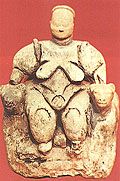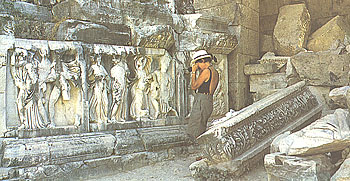|
 Turkey
occupies a unique geographical and cultural position at the cross-roads between Europe and Asia. The country is
undergoing rapid and far-reaching changes in its social, economic and cultural life. Many of the most important
of these changes are connected with the transformation of an essentially rural society into a mainly urban and
industrial one. However nearly half of all workers in the country are employed in the agricultural sector and agriculture
makes a significant contribution to the economy. Turkey
occupies a unique geographical and cultural position at the cross-roads between Europe and Asia. The country is
undergoing rapid and far-reaching changes in its social, economic and cultural life. Many of the most important
of these changes are connected with the transformation of an essentially rural society into a mainly urban and
industrial one. However nearly half of all workers in the country are employed in the agricultural sector and agriculture
makes a significant contribution to the economy.
Do you want to live summer in winter, or both at the same time? Or, would you prefer a beautiful springtime
in countryside which is a constant wonder? Perhaps a romantic autumn in Istanbul is what you have in mind.
Turkey offers variety and diversity in virtually everything. That is why even a short visit feels like a long journey
to be remembered. Turkey is a land of culture, natural beauty, sun, sea, history, and people.

Throughout the known history of mankind this land has acted as a bridge not only between continents, but between
cultures as well. Civilisation after civilisation arose on this soil, built cities, flourished, fought wars and
vanished leaving landmarks everywhere.
Cradle of Civilisations: 3,000 settlements of 35 civilisations
Artefacts and instruments dating back as early as 10000 BC during the Stone Age and 8000 BC during the Neolithic
Age have been found. Ancient powers which have come and gone include the Hittites from 2000 to 1200 BC, the Urartu
people from ninth to sixth Centuries B.C, the Phrygians of King Midas fame who flourished and vanished around 8th
Century BC, The Lydians warred against the invading Persians in the year 546 BC and than Alexander the Great droves
the Persians out, so ushering in the Hellenistic Period in 330 BC The Kingdom of Pergamum was assimilated by the
Roman Empire in 133 BC The Eastern and Western regions of the Roman Empire split in 395 AD, the East becoming the
Byzantine Empire. In 1071 AD, came the Seljuk Turks, who were succeeded by the Ottomans in 1299 AD Finally the
modern Republic of Turkey was established in 1923...
There is probably no other land on earth that has seen so much action.
VII. History
The
first major civilization in what is now Turkey, the Hittites,
originated in Anatolia's central plateau about 1900 to 1200 BC. Invaders known as the Sea Peoples
invaded and swept over Asia Minor in late 12th century BC, destroying the Hittites. Several different
kingdoms rose and fell over the centuries, including those of the Phrygians, the Cimmerians, and the Lydians. From
the mid-6th century to 333 BC most of Asia Minor, including Anatolia, belonged to the Persian Empire,
which was supplanted by the Macedonian Empire about 333 BC.
In
the 2nd and 1st centuries BC, Asia Minor was gradually conquered by the Romans. When the Roman Empire
divided in the 4th century AD, Asia Minor became part of the Eastern Roman Empire, or Byzantine
Empire, the capital of which was Constantinople
(present-day Istanbul), or Byzantium.
During
the 11th century, nomadic Seljuk
Turks, the predecessors of the Ottoman Empire,
first invaded Asia Minor. Osman, who conquered much of Anatolia, was the founder of the Ottoman dynasty in the
early 14th century. The Ottomans were Turkoman leaders who had fought the Byzantines in northwestern Anatolia.
The transformation of the Ottoman principality into a vast empire, covering southeastern Europe, Anatolia, and
the Arab world, was accomplished in three major campaigns between the 14th and 16th centuries. It reached its peak
during the reign of Suleiman I
the Magnificent, who completed the Ottoman expansion in 1529. However, toward the end of his reign, the empire
began a decline that continued until the end of World War I in 1918, when it was totally dismantled.
During
the 19th century, the continuous danger of foreign conquest was aggravated by the rise of nationalism. One after
another, the non-Turkish peoples of the Ottoman Empire sought and obtained independence. The Ottoman ruling class
responded to these crises with a concentrated effort at reform known as the Tanzimat
(Turkish for "reorganization").
A
second round of major reforms came in what is known as the Young Turk Revolution (1908), when the liberal opposition
dethroned the sultan. The early years of the Young Turk era were the most democratic period of Ottoman history,
with reforms reaching all areas of life.
Asia Minor, region of the ancient world, roughly corresponding to present Asian Turkey, or the peninsula of Anatolia.
Some of the earliest Neolithic settlements in the Middle East have been found in Asia Minor. One of the most important,
at Çatal Hüyük, near present Konya, dates from as early as 9000 BC.
Early Indigenous States
Of the Anatolian cultures of the succeeding Bronze Age, the most important was that of the Hittites, about 1900-1200
BC, which originated in the central plateau. At its widest extent, the Hittite Empire covered most of Asia Minor
and rivaled Egypt as a Middle Eastern power. It was destroyed by invaders known as the Sea Peoples, who swept over
Asia Minor and Syria toward the end of the 12th century BC. The destruction of the western Anatolian city of Troy,
an event celebrated in ancient Greek legends, probably occurred during these invasions.
One of the Sea Peoples, the Phrygians, established a kingdom that became the dominant Anatolian power in the 9th
and 8th centuries BC. Their king, Midas, was credited by the Greeks with the power to change anything he touched
into gold. Hittite culture survived in Carchemish, Milid (present-day Malatya, Turkey), and other small states
in eastern Asia Minor until about 700 BC. During this same period the Greeks founded Miletus, Ephesus, and Priene
and a number of other cities in Ionia, an area along the Aegean coast. About 700 BC the Phrygian kingdom was overrun
and destroyed by the Cimmerians, a nomadic people who thereafter lived in western Asia Minor. In the 7th century
BC the Lydians also appeared near the Aegean coast, where they founded a kingdom, the capital of which was Sardis.
According to Greek writers, they were the first people to coin money. Their last king, Croesus, fabled for his
wealth, was overthrown by the Persians under Cyrus the Great in 546 BC.
Foreign Rule
From the mid-6th century to 333 BC most of Asia Minor belonged to the Persian Empire, although the Greek cities
frequently enjoyed a considerable degree of autonomy. In the 4th century BC Persian power declined, and after 333
BC it was supplanted by the Macedonian Empire of Alexander the Great. After Alexander's death, his realm was divided
among his followers, Asia Minor falling to the Seleucid kings of Syria, except for Lycia and Caria on the south
coast, which were governed by the Ptolemies of Egypt. In the 3rd century BC, Bithynia and Pontus in the north and
Cappadocia in the east became independent; Celtic invaders settled in central Asia Minor, in an area thenceforth
known as Galatia; and the kingdom of Pergamum was established on the Aegean coast. In the 2nd and 1st centuries
BC, Asia Minor was gradually conquered by the Romans. For the most part the region prospered under Roman rule,
and its cities flourished as centers of Greek culture.
|